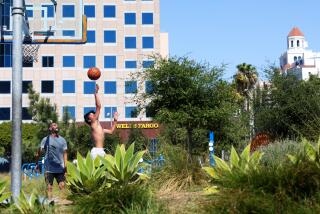History at their fingertips
In 1999, Long Beach author, genealogist and lecturer Aaron L. Day was given a volunteer of the year award named after Mary Dell Butler, the first African American woman in that city’s history to have a school named after her. But when he tried to learn more about the woman for whom the award was named, Day was stumped.
“I went to the school to see if they had any literature about her and they didn’t have anything,” Day recalled. “They had a plaque in the lobby area.”
Imagine that, he thought. Someone important enough to name a school after, yet no one knows anything about her.
Similar thoughts went through Indira Hale Tucker’s mind when, in the late 1980s, she was leafing through an official history of Long Beach and found only three words about the city’s African American community: “11 percent black.”
Tucker said she was “flabbergasted.” How could Long Beach, one of America’s larger municipalities, have so little in the way of documented information about blacks who migrated to the city, put down roots, raised families, started businesses and took their places in the corridors of civic politics, the law and other public and private institutions?
That oversight has begun to be addressed with the publication of a new book titled “The Heritage of African Americans in Long Beach: Over 100 Years” (Infinity Publishing).
Edited by Tucker and Day, the president and vice president, respectively, of the African American Heritage Society of Long Beach, the book is a 300-page compilation of personal stories, news accounts, family and community photographs and even census data that the society hopes will allow blacks to research their ancestry.
In recent weeks, Long Beach has been rocked by controversy over race relations, including the trial of nine black youths who were convicted of joining a mob beating of three white women on Halloween night, and the Hilary Swank film “Freedom Writers,” which drew criticism for depicting relatively affluent Woodrow Wilson High School as a bastion of inner-city turmoil.
Day, a retired accountant who moved to Los Angeles from Ohio in 1964 and took up residence in Long Beach in 1980, said that many young African Americans aren’t familiar with their local history.
“So many of our young people think about the slavery issue, but they don’t know what happened between [the Civil War] and now,” he said.
The book notes that there were only 21 African Americans residing in Long Beach in 1900, but their numbers increased in 1906 when Baptist minister Jasen Lee brought 12 families from St. Louis, who settled along Alamitos Avenue and Anaheim Street. In 1940, there were 600 blacks. It wasn’t until the advent of World War II that the numbers grew to 6,000. Today, the African American population is about 70,000.
Among the most prominent black residents was Ernest S. McBride Sr., now in his 80s, who helped organize the local branch of the NAACP in 1940. He led a protest that eliminated blackface minstrel shows performed by Long Beach School District.
The book provides fleeting glimpses into a community’s past, with brief entries about Captain S.W. Hawkins, who owned his own ranch in Long Beach, and Elizabeth M. Moore, a former slave who died in 1918.
There is the first black dentist in Long Beach, Ebenezer B. Bush, who at 86 continues a successful practice; the first black fireman, Otis Reed; the first black policeman, Warren Jordan; the first black cashier at Cole’s Market, Howard Hall; the first black restaurant owner, Leon Price; the first Long Beach black rock ‘n’ roll group, the Debonairs.
There was Walter McGowen II, the first black football player at Long Beach Poly High, who helped the Jackrabbits win the Coast League and Southern California championship in 1934. Sportswriters dubbed him the “Ebony Express.”
“He wanted to be a policeman but there was no way [in those days],” Day noted. “He ended up going into business. He had a couple supermarkets, a pool hall, a couple other places.”
Tucker, who was raised in Hawaii and moved to Long Beach in 1977, is the wife of Marcus O. Tucker, the first African American judge in the Long Beach Municipal Court. She noted that when he first ran for office, some of their friends in Los Angeles told them he could never get elected because of Long Beach’s low black voter base.
“People in Long Beach, on the other hand, and not only African Americans, did not have that attitude,” she said. “It was a tough race, but ultimately he prevailed.”
Many blacks who came to Long Beach took jobs shining shoes, or working as janitors, maids and cooks. Some arrived after joining the Navy. But wherever they came from, they found that prejudice knew no boundaries.
The book contains news accounts of a protest by “colored residents” in 1919 seeking to abolish a pastime at the local amusement park, the Pike. Variously dubbed “dunking the darky” and the “African dip,” it involved throwing a baseball at a target that, when struck, would send a black person into a tank of water. Long Beach also had an active Ku Klux Klan chapter in the 1920s. A 1924 KKK rally was attended by 7,500 people in Recreation Park, according to a news account published in the book.
Day believes the book, available on the Internet at www.aahslb.org, can help bridge cultural divides. “We wanted to not only motivate the African American community to researching, documenting and preserving their history, but use it as a connection to other cultures to read about what our people experienced and maybe bring some sensitivity to what they went through.”
Day said they already are collecting material for the next book, which he envisions will be published in January 2009.
More to Read
Sign up for our Book Club newsletter
Get the latest news, events and more from the Los Angeles Times Book Club, and help us get L.A. reading and talking.
You may occasionally receive promotional content from the Los Angeles Times.








